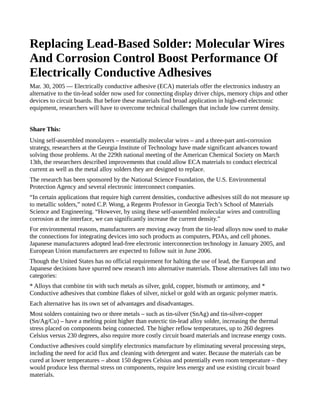Untitled 1
- 1. Replacing Lead-Based Solder: Molecular Wires And Corrosion Control Boost Performance Of Electrically Conductive Adhesives Mar. 30, 2005 ŌĆö Electrically conductive adhesive (ECA) materials offer the electronics industry an alternative to the tin-lead solder now used for connecting display driver chips, memory chips and other devices to circuit boards. But before these materials find broad application in high-end electronic equipment, researchers will have to overcome technical challenges that include low current density. Share This: Using self-assembled monolayers ŌĆō essentially molecular wires ŌĆō and a three-part anti-corrosion strategy, researchers at the Georgia Institute of Technology have made significant advances toward solving those problems. At the 229th national meeting of the American Chemical Society on March 13th, the researchers described improvements that could allow ECA materials to conduct electrical current as well as the metal alloy solders they are designed to replace. The research has been sponsored by the National Science Foundation, the U.S. Environmental Protection Agency and several electronic interconnect companies. ŌĆ£In certain applications that require high current densities, conductive adhesives still do not measure up to metallic solders,ŌĆØ noted C.P. Wong, a Regents Professor in Georgia TechŌĆÖs School of Materials Science and Engineering. ŌĆ£However, by using these self-assembled molecular wires and controlling corrosion at the interface, we can significantly increase the current density.ŌĆØ For environmental reasons, manufacturers are moving away from the tin-lead alloys now used to make the connections for integrating devices into such products as computers, PDAs, and cell phones. Japanese manufacturers adopted lead-free electronic interconnection technology in January 2005, and European Union manufacturers are expected to follow suit in June 2006. Though the United States has no official requirement for halting the use of lead, the European and Japanese decisions have spurred new research into alternative materials. Those alternatives fall into two categories: * Alloys that combine tin with such metals as silver, gold, copper, bismuth or antimony, and * Conductive adhesives that combine flakes of silver, nickel or gold with an organic polymer matrix. Each alternative has its own set of advantages and disadvantages. Most solders containing two or three metals ŌĆō such as tin-silver (SnAg) and tin-silver-copper (Sn/Ag/Cu) ŌĆō have a melting point higher than eutectic tin-lead alloy solder, increasing the thermal stress placed on components being connected. The higher reflow temperatures, up to 260 degrees Celsius versus 230 degrees, also require more costly circuit board materials and increase energy costs. Conductive adhesives could simplify electronics manufacture by eliminating several processing steps, including the need for acid flux and cleaning with detergent and water. Because the materials can be cured at lower temperatures ŌĆō about 150 degrees Celsius and potentially even room temperature ŌĆō they would produce less thermal stress on components, require less energy and use existing circuit board materials.
- 2. ŌĆ£Conductive adhesives have a lot of advantages, but there are a few challenges,ŌĆØ Wong noted. ŌĆ£After you attach a component to a board with conductive adhesives and then cure it, you must test the connections under conditions of high humidity and heat. When you do that, electrical resistance in the joints increases and conductivity drops. That is a major problem for the industry.ŌĆØ At first, scientists and engineers believed the problem was caused by oxidation. But Wong and colleagues at the National Science Foundation-supported Microsystems Packaging Research Center showed that galvanic corrosion, caused by contact between dissimilar metals in the adhesive and tin- lead alloys used in device contacts, was the real culprit. They have since published numerous papers describing strategies for fighting corrosion. ŌĆ£By understanding this galvanic corrosion, we can develop improved materials that use an inhibitor such as acid to protect the contacts from corrosion, and we can use an oxygen scavenger such as hydroquinone to grab the oxygen required for corrosion to take place,ŌĆØ he said. ŌĆ£We can also include a sacrificial material with a lower potential metal that is first attacked by corrosion process, sparing the conductive materials.ŌĆØ Further improvements were made by substituting short-chain dicarboxylic acids for the surfactant stearic acid used to prevent agglomeration of the silver flakes. Replacing or reducing the stearic acid ŌĆō which acts as an insulator around the silver flakes ŌĆō further improved current flow. Still, the current density accommodated by conductive adhesives fell short of whatŌĆÖs needed to support power-hungry devices like processors. To overcome that challenge, Wong and collaborators Grace Yi Li and Kyoung-sik Moon developed self-assembled monolayers (SAM) ŌĆō essentially molecular wires ŌĆō made up of sulfur-containing conductive materials known as thiols. Less than 10 Angstroms long, these molecules chemically bind to gold pads in the device and board, providing a direct electrical connection that bypasses the resistance normally found at the interface. ŌĆ£Recent studies show that with incorporation of these self-assembled monolayers, the electrical conductivity and current-carrying capability of conductive adhesives could compete well with traditional solder joints,ŌĆØ Wong said. ŌĆ£This could be a significant advance in improving these materials.ŌĆØ But like many advances, the SAM structures arenŌĆÖt yet optimized. Testing shows that they begin to decompose at temperatures above 150 degrees Celsius. ŌĆ£We need additional research in this area to develop more stable materials that are still able to carry the current density required and have the necessary mechanical properties,ŌĆØ said Li, a graduate student in WongŌĆÖs laboratory. Georgia Tech has applied for patents on the self-assembled monolayer, and on the techniques for controlling corrosion.
- 3. Researcher Grace Yi Li holds samples of electrically conductive adhesive being studied in the laboratory of Professor C.P. Wong in Georgia Tech's School of Materials Science and Engineering. (Georgia Tech Photo: Gary Meek )



